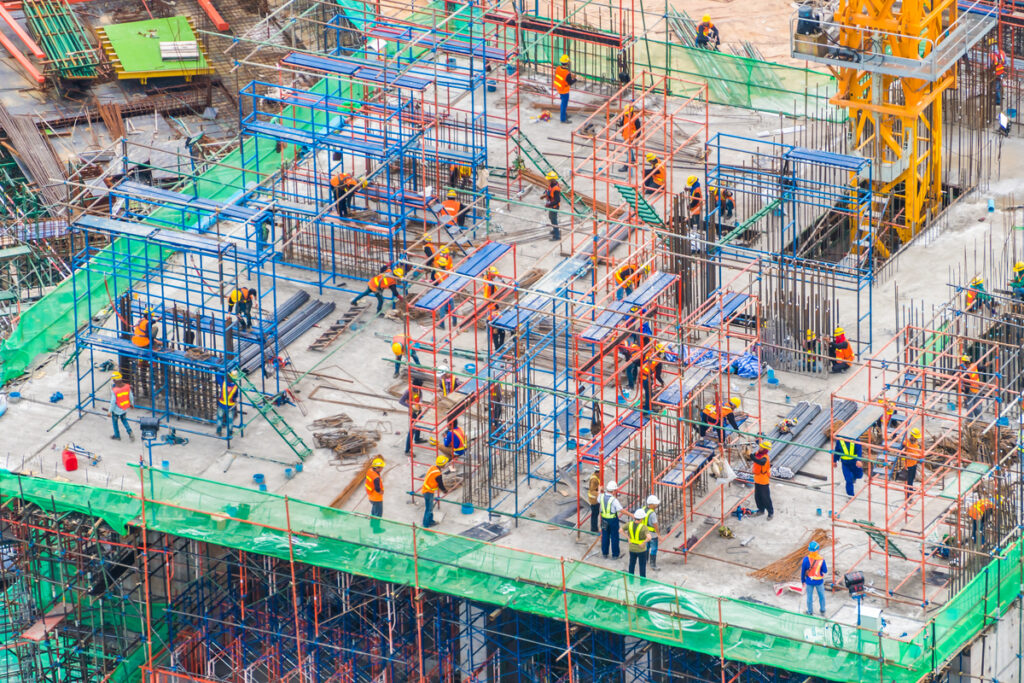Updated by Nazanin Ghodsian, 08/20/2024
Construction project schedules, costs, and productivity are all negatively impacted by theft detection in construction, which is still a major problem. According to the National Equipment Register, the theft of construction equipment alone costs the US economy more than $300 million per year. Theft of equipment, supplies, and other assets further increases the financial burden by causing delays in projects, increased insurance costs, and harm to the reputation of construction companies.
Given these troubling facts, construction companies must adopt construction companies to adopt proactive strategies for theft detection in construction and protect their assets. To reduce the danger of theft and preserve a safe workplace, a comprehensive strategy that incorporates improved security measures, staff training, cutting-edge technology, cooperation with law enforcement, vendor screening, and secure storage procedures should be put into place.
This article explores practical methods and best practices for theft detection in construction. It discusses how businesses can lower risks, strengthen security posture, and guard important assets from loss and unwanted access. Using data analytics, incorporating cutting-edge technology, and encouraging a security-aware and accountable culture are important strategies.
Table of Contents
Ways to Prevent Theft Detection in Construction
Theft detection in construction poses a significant challenge in the construction industry, leading to losses in materials, equipment, and productivity. To combat this issue, construction companies must proactively implement strategies to prevent theft and minimize the risk of detection. Here are several effective approaches to enhance security and deter theft detection on construction sites:
Suggested article to read: Construction Monitoring Solutions: Your Complete Guide
1. Enhanced Site Security Measures
Enhanced site security measures are essential for safeguarding construction sites against theft and unauthorized access. By implementing comprehensive security protocols and utilizing advanced technology, construction companies can significantly reduce the risk of theft detection in construction and protect valuable assets. Here’s a closer look at some key strategies for enhancing site security:
- Comprehensive Surveillance Systems:
- Installing closed-circuit television (CCTV) cameras strategically throughout the construction site to monitor activity in real-time.
- Utilizing high-definition cameras with night vision capabilities to ensure 24/7 surveillance coverage.
- Integrating CCTV systems with motion sensors and alarms to prompt immediate response to suspicious activity.
- Access Control Systems:
- Implementing access control systems to regulate entry and exit points on the construction site.
- Utilizing electronic key cards, biometric scanners, or PIN codes to authenticate personnel and restrict unauthorized access.
- Logging entry and exit times to track employee movements and identify any anomalies.
- Security Patrols and Guards:
- Employing trained security personnel to conduct regular patrols of the construction site.
- Assigning guards to monitor high-risk areas and respond swiftly to any security breaches.
- Providing guards with communication devices to coordinate effectively with onsite management and law enforcement if needed.
- Advanced Technology Integration:
- Incorporating advanced technology solutions such as drones for aerial surveillance and monitoring of large construction sites.
- Deploying motion sensors and infrared detectors to detect intruders and trigger immediate alerts.
- Integrating security systems with centralized monitoring platforms for centralized control and management.
- Perimeter Security:
- Securing the perimeter of the construction site with fencing, barriers, or barricades to deter unauthorized entry.
- Implementing access gates with controlled entry points and vehicle barriers to prevent vehicle-based theft.
- Using signage to warn trespassers and deter potential thieves from attempting to breach the site.
- Emergency Response Planning:
- Developing and regularly updating emergency response plans to address security incidents such as theft, vandalism, or trespassing.
- Training onsite personnel on emergency procedures and protocols for responding to security threats.
- Establishing communication channels with local law enforcement agencies to facilitate rapid response and coordination during emergencies.
- Regular Security Audits and Reviews:
- Conducting regular security audits to assess the effectiveness of existing security measures and identify areas for improvement.
- Reviewing surveillance footage and incident reports to analyze patterns of security breaches and adjust security strategies accordingly.
- Soliciting feedback from onsite personnel and security providers to ensure security measures are aligned with the evolving needs of the construction site.
Enhanced site security measures are critical for mitigating the risk of theft detection in construction and protecting construction sites from unauthorized access and criminal activity. By implementing a combination of physical security measures, advanced technology solutions, and proactive security protocols, construction companies can create a secure environment conducive to project success.

2. Employee Training and Awareness
Employee training and awareness play a crucial role in enhancing construction site security and preventing theft detection in construction. By educating personnel about security risks, implementing strict protocols, and fostering a culture of vigilance, construction companies can significantly reduce vulnerabilities and mitigate the risk of theft. Here’s an in-depth look at the importance of employee training and awareness in construction site security:
- Security Awareness Training:
- Conducting comprehensive security awareness training programs for all employees, including construction workers, supervisors, and administrative staff.
- Educating employees about the types of security threats prevalent on construction sites, such as theft, vandalism, and sabotage.
- Providing guidance on identifying suspicious activities, reporting procedures, and emergency response protocols.
- Access Control Protocols:
- Training employees on access control protocols, including procedures for entering and exiting the construction site, checking in visitors, and verifying credentials.
- Emphasizing the importance of strict adherence to access control measures to prevent unauthorized entry and limit opportunities for theft detection in construction.
- Providing clear guidelines on securing equipment, tools, and materials when not in use to minimize the risk of theft.
- Material Handling Procedures:
- Educating employees on proper material handling procedures to reduce the risk of loss or theft.
- Emphasizing the importance of securely storing materials in designated areas and utilizing locking mechanisms when necessary.
- Training workers on inventory management systems and barcode scanning techniques to track material movement accurately.
- Recognizing Security Threats:
- Teaching employees how to recognize potential security threats, such as unfamiliar individuals on the construction site, suspicious vehicles, or unauthorized access attempts.
- Providing examples of common tactics used by thieves and vandals to infiltrate construction sites and steal valuable assets.
- Encouraging employees to trust their instincts and report any unusual or concerning behavior to onsite security personnel or management.
- Response to Security Incidents:
- Conducting drills and simulations to prepare employees for responding effectively to security incidents, including theft detection in construction, vandalism, or emergencies.
- Establishing clear communication channels for reporting security breaches and activating emergency response procedures.
- Training employees on basic self-defense techniques and de-escalation strategies to protect themselves and others during security incidents.
- Reinforcing Security Culture:
- Promoting a culture of security awareness and accountability among employees by recognizing and rewarding proactive security behaviors.
- Incorporating security awareness into regular safety meetings, toolbox talks, and training sessions to reinforce its importance.
- Encouraging open communication and collaboration among employees to identify and address security concerns collectively.
Employee training and awareness are integral components of a comprehensive construction site security strategy. By investing in ongoing education and empowering employees to play an active role in security risk mitigation, construction companies can create a safer and more secure working environment for their personnel and protect valuable assets from theft and vandalism.
Suggested article to read: 5 Workers Monitoring Solutions in Construction Industry
3. Inventory Management Systems
Inventory management systems are indispensable tools for construction companies seeking to improve security and prevent theft detection on their sites. By implementing robust systems for tracking materials, tools, and equipment, construction firms can enhance accountability, streamline operations, and mitigate the risk of inventory-related losses. Here’s an exploration of the key components and benefits of implementing inventory management systems in construction site security:
- Centralized Tracking and Monitoring:
- Utilizing centralized inventory management software to track the movement and location of materials, tools, and equipment in real-time.
- Implementing barcode scanning or RFID technology to assign unique identifiers to each item and streamline data capture processes.
- Providing stakeholders with access to a centralized dashboard for monitoring inventory levels, transactions, and historical data.
- Accurate Inventory Records:
- Establishing digital records of all inventory items, including descriptions, quantities, serial numbers, and purchase details.
- Regularly updating inventory records to reflect incoming deliveries, usage, transfers between sites, and disposals.
- Conducting periodic physical audits to reconcile digital inventory records with actual stock levels and identify discrepancies.
- Theft Detection in Construction and Prevention:
- Enhancing security by implementing inventory management systems that include features for detecting and preventing theft.
- Setting up alerts for unusual inventory movements, such as unauthorized transfers or excessive withdrawals.
- Implementing access controls and user permissions to restrict access to inventory data and transactions based on job roles and responsibilities.
- Material Requisition and Approval:
- Implementing workflows for material requisition and approval to ensure accountability and prevent unauthorized withdrawals.
- Requiring employees to submit formal requests for materials, tools, or equipment, along with justifications and approval from designated authorities.
- Recording all material transactions and documenting the purpose, recipient, and usage details for audit purposes.
- Streamlined Procurement and Replenishment:
- Leveraging inventory management systems to optimize procurement processes and prevent stockouts or delays.
- Setting up automatic reorder triggers based on predefined inventory thresholds to ensure timely replenishment of critical items.
- Streamlining vendor management and procurement workflows through integration with supplier databases and electronic purchase order systems.
- Improved Resource Allocation:
- Utilizing inventory data analytics to optimize resource allocation and minimize excess inventory or overstocking.
- Identifying usage patterns and trends to forecast future material requirements more accurately and adjust procurement strategies accordingly.
- Allocating resources based on project priorities, timelines, and budget constraints to optimize project efficiency and profitability.
- Enhanced Accountability and Transparency:
- Promoting accountability among employees by establishing clear roles, responsibilities, and procedures for inventory management.
- Providing training and support to ensure that personnel understand their obligations regarding inventory handling, usage, and reporting.
- Fostering a culture of transparency by regularly communicating inventory-related policies, procedures, and performance metrics to employees and stakeholders.
Implementing inventory management systems is essential for construction companies aiming to enhance security, improve operational efficiency, and protect valuable assets from theft detection in construction. By leveraging technology to track, monitor, and manage inventory effectively, construction firms can minimize the risk of inventory-related losses and maintain a secure working environment on their sites.
4. Collaboration with Law Enforcement
Collaboration with law enforcement agencies is a critical component of construction site security strategies aimed at preventing theft detection in construction and minimizing criminal activity. By establishing partnerships with local law enforcement, construction companies can access valuable resources, expertise, and support to enhance security measures and respond effectively to security threats. Here’s a detailed examination of the benefits and best practices for collaborating with law enforcement in construction site security:
- Establishing Partnerships:
- Proactively reaching out to local law enforcement agencies, including police departments and sheriff’s offices, to initiate collaboration efforts.
- Building relationships with law enforcement personnel, such as community policing officers or crime prevention specialists, who can provide guidance and support.
- Information Sharing:
- Sharing information with law enforcement agencies about past security incidents, patterns of criminal activity, and areas of concern on construction sites.
- Providing law enforcement with access to surveillance footage, incident reports, and other relevant data to aid in investigations and apprehension of suspects.
- Coordinating Patrols and Response:
- Collaborating with law enforcement to coordinate patrols and surveillance efforts in and around construction sites, especially during periods of increased vulnerability, such as nights and weekends.
- Establishing protocols for responding to security breaches and activating law enforcement support in the event of theft, vandalism, or other criminal activity.
- Training and Education:
- Providing training opportunities for law enforcement personnel to familiarize them with the unique security challenges and vulnerabilities faced by construction sites.
- Offering educational workshops or seminars on construction site security best practices, crime prevention strategies, and relevant laws and regulations.
- Joint Operations and Task Forces:
- Participating in joint operations and task forces led by law enforcement agencies to address specific security concerns, such as organized theft rings targeting construction sites.
- Collaborating with law enforcement task forces focused on combating property crime, burglary, or theft in the local community.
- Enhanced Response Capabilities:
- Leveraging law enforcement resources and expertise to enhance response capabilities in the event of security incidents or emergencies on construction sites.
- Establishing communication protocols and emergency response procedures for coordinating with law enforcement agencies during critical incidents.
- Public Awareness and Engagement:
- Partnering with law enforcement to raise public awareness about construction site security issues and the importance of reporting suspicious activity.
- Engaging with the local community through outreach events, neighborhood watch programs, and crime prevention initiatives to foster a collaborative approach to security.
- Legal Support and Advocacy:
- Seeking legal support and advocacy from law enforcement agencies in prosecuting individuals involved in theft, vandalism, or other criminal activities on construction sites.
- Collaborating with law enforcement to advocate for stronger legislation and enforcement measures to deter theft and protect construction industry assets.
By forging strong partnerships with law enforcement agencies and actively collaborating on security initiatives, construction companies can strengthen their defenses against theft detection in construction and create safer environments for their personnel, projects, and communities. Effective collaboration with law enforcement is essential for deterring criminal activity, apprehending perpetrators, and safeguarding valuable assets on construction sites.
Suggested article to read: TokenMe: Monitoring Solution in Construction Industry
5. Vendor and Contractor Screening
Vendor and contractor screening is a critical aspect of construction site security, ensuring that only trustworthy and reliable partners are allowed access to the site. By implementing thorough screening processes, construction companies can minimize the risk of theft detection in construction, vandalism, and other security threats posed by external parties. Here’s a detailed exploration of the importance and best practices for vendor and contractor screening in construction site security:
- Establishing Screening Criteria:
- Developing clear criteria for evaluating vendors and contractors based on factors such as reputation, experience, financial stability, and adherence to safety and security standards.
- Defining specific requirements for vendor and contractor qualifications, certifications, licenses, insurance coverage, and compliance with regulatory requirements.
- Background Checks and Verification:
- Conducting comprehensive background checks on vendors and contractors to verify their identity, credentials, and legal status.
- Verifying references, past performance, and customer feedback to assess the reliability, professionalism, and trustworthiness of potential partners.
- Screening for criminal records, litigation history, and regulatory violations that may indicate potential security risks or unethical behavior.
- Financial Due Diligence:
- Assessing the financial stability and solvency of vendors and contractors to ensure their ability to fulfill contractual obligations and maintain business continuity.
- Requesting financial statements, credit reports, and proof of insurance coverage to evaluate financial health and risk exposure.
- Monitoring for signs of financial distress or instability that may impact the vendor or contractor’s ability to deliver goods or services as agreed.
- Security Clearance and Training:
- Requiring vendors and contractors to undergo security clearance procedures, including background checks and security training, if access to sensitive areas or assets is required.
- Providing guidelines and training on construction site security protocols, access control procedures, and reporting requirements to ensure compliance with security policies and regulations.
- Holding vendors and contractors accountable for the conduct and behavior of their employees and subcontractors while on-site.
- Contractual Agreements and Compliance:
- Establishing clear contractual agreements outlining security requirements, responsibilities, and expectations for vendors and contractors.
- Including provisions for security compliance, confidentiality, data protection, and liability insurance coverage in vendor and contractor contracts.
- Implementing mechanisms for monitoring and enforcing security standards through regular audits, inspections, and performance evaluations.
- Ongoing Monitoring and Evaluation:
- Implementing a system for ongoing monitoring and evaluation of vendors and contractors to ensure continued compliance with security requirements and performance expectations.
- Regularly reviewing vendor and contractor performance, incident reports, and security-related metrics to identify areas for improvement and address potential security vulnerabilities.
- Maintaining open communication channels with vendors and contractors to address security concerns, provide feedback, and collaborate on security initiatives.
- Continuous Improvement and Adaptation:
- Continuously reviewing and updating vendor and contractor screening processes based on lessons learned, industry best practices, and emerging security threats.
- Staying informed about changes in regulations, standards, and technology solutions related to vendor and contractor security screening.
- Collaborating with industry peers, security experts, and law enforcement agencies to share insights and lessons learned and strengthen collective security efforts.
Effective vendor and contractor screening is essential for maintaining construction site security and protecting against theft detection in construction, vandalism, and other security risks. By implementing rigorous screening processes, construction companies can minimize security vulnerabilities, safeguard valuable assets, and ensure the integrity and success of their projects.

6. Data Analytics and Technology Integration
Data analytics and technology integration are powerful tools that construction companies can leverage to enhance site security, detect theft, and mitigate risks effectively. By harnessing the capabilities of advanced technology and analytics, construction firms can proactively identify security threats, monitor site activity in real-time, and optimize security operations. Here’s an in-depth exploration of how data analytics and technology integration contribute to construction site security:
- Real-Time Monitoring and Surveillance:
- Deploying advanced surveillance systems equipped with cameras, sensors, and IoT devices to monitor construction sites in real-time.
- Integrating surveillance footage with data analytics platforms to detect anomalies, identify security breaches, and trigger immediate alerts.
- Utilizing video analytics algorithms to recognize suspicious behavior patterns and differentiate between normal and abnormal activities.
- Predictive Analytics for Threat Detection:
- Implementing predictive analytics models to anticipate security threats and preemptively address vulnerabilities.
- Analyzing historical data, such as past security incidents, weather patterns, and site activity trends, to identify potential risk factors and patterns.
- Using predictive algorithms to forecast high-risk periods or areas susceptible to theft detection in construction and allocating resources accordingly.
- RFID and GPS Tracking for Asset Management:
- Utilizing RFID tags and GPS tracking devices to monitor the location and movement of valuable assets, materials, and equipment on construction sites.
- Integrating RFID and GPS data with inventory management systems to maintain accurate asset records, track usage, and prevent theft detection in construction.
- Implementing geofencing technology to create virtual boundaries around restricted areas and receive alerts when assets are moved outside designated zones.
- Access Control and Biometric Authentication:
- Integrating access control systems with biometric authentication technologies, such as fingerprint or facial recognition, to verify the identity of personnel accessing the construction site.
- Using centralized access control platforms to manage user permissions, restrict unauthorized entry, and track employee movements.
- Analyzing access control data to identify patterns of unauthorized access attempts or suspicious behavior and take corrective action.
- Mobile Applications for Security Management:
- Developing mobile applications for security personnel to access real-time surveillance feeds, incident reports, and security alerts from anywhere.
- Integrating mobile applications with incident management systems to streamline communication, response coordination, and documentation of security incidents.
- Empowering security teams with mobile tools for incident reporting, image capture, and GPS location tracking to enhance situational awareness and response capabilities.
- Cloud-Based Analytics and Collaboration:
- Leveraging cloud-based analytics platforms to aggregate and analyze data from multiple sources, including surveillance cameras, sensors, and access control systems.
- Facilitating collaboration and information sharing among stakeholders, security teams, and law enforcement agencies through secure cloud-based platforms.
- Harnessing the scalability and flexibility of cloud-based solutions to adapt to changing security requirements, scale operations, and accommodate future technology advancements.
- Continuous Improvement and Optimization:
- Continuously monitoring and analyzing security data to identify areas for improvement, optimize security strategies, and enhance overall effectiveness.
- Embracing a culture of innovation and experimentation to explore emerging technologies, such as artificial intelligence and machine learning, for advanced threat detection and prediction.
- Investing in employee training and skill development to ensure personnel are equipped to leverage data analytics and technology tools effectively for construction site security.
By harnessing the power of data analytics and technology integration, construction companies can strengthen their security posture, detect and prevent theft, and create safer environments for their personnel and projects. By adopting a proactive approach to security management and leveraging innovative solutions, construction firms can stay ahead of evolving security threats and protect valuable assets from theft detection in construction and other risks.
7. Secure Storage and Asset Tracking
Secure storage and asset tracking are paramount for construction companies aiming to prevent theft detection in construction and safeguard valuable materials and equipment on-site. By implementing robust storage solutions and advanced tracking systems, construction firms can minimize the risk of unauthorized access and loss, enhancing overall site security. Here’s a detailed exploration of secure storage practices and asset tracking strategies for construction site security:
- Establishing Secure Storage Areas:
- Designating secure storage areas within the construction site perimeter to store high-value materials, tools, and equipment.
- Implementing physical barriers, such as fences, gates, or locked enclosures, to restrict access to secure storage areas and deter unauthorized entry.
- Installing surveillance cameras and motion sensors to monitor secure storage areas and detect potential security breaches.
- Utilizing Locking Mechanisms and Security Features:
- Equipping storage containers, tool cribs, and equipment enclosures with sturdy locks, padlocks, or electronic access controls to prevent unauthorized access.
- Installing tamper-evident seals and security tags on valuable assets to deter tampering and provide visual indicators of security breaches.
- Employing reinforced doors, windows, and barriers with anti-tamper features to fortify secure storage areas against forced entry attempts.
- Implementing Asset Tracking Systems:
- Deploying RFID tags, barcode labels, or GPS tracking devices to track the location and movement of materials, tools, and equipment in real-time.
- Integrating asset tracking systems with inventory management software to maintain accurate records, monitor usage, and identify discrepancies.
- Utilizing cloud-based asset tracking platforms to centralize asset data, automate tracking processes, and enable remote monitoring from any location.
- Geofencing and Location-Based Alerts:
- Establishing virtual geofences around secure storage areas and designated construction zones to define permissible boundaries and monitor asset movements.
- Configuring location-based alerts and notifications to trigger automatic alerts when assets are moved outside predefined zones or enter unauthorized areas.
- Integrating geofencing capabilities with mobile applications or security monitoring systems to enable immediate response to unauthorized asset movements.
- Regular Inventory Audits and Inspections:
- Conducting regular inventory audits and inspections to reconcile asset records, verify physical inventory levels, and identify discrepancies or missing items.
- Performing visual inspections of secure storage areas to ensure physical security measures are intact and functioning effectively.
- Documenting audit findings, discrepancies, and corrective actions taken to maintain accountability and transparency in asset management.
- Employee Training and Accountability:
- Providing training to employees on proper asset handling procedures, security protocols, and reporting requirements to prevent theft and unauthorized access.
- Implementing access controls and user permissions to restrict employee access to secure storage areas based on job roles and responsibilities.
- Holding employees accountable for adherence to security policies and procedures through performance evaluations, audits, and disciplinary measures as necessary.
- Collaboration with Security Providers and Law Enforcement:
- Collaborating with security service providers to enhance monitoring, surveillance, and response capabilities for secure storage areas.
- Establishing partnerships with law enforcement agencies to report security incidents, investigate thefts, and recover stolen assets through coordinated efforts.
- Sharing information and intelligence with security providers and law enforcement agencies to identify trends, patterns, and emerging threats related to asset theft and security breaches.
By implementing secure storage practices and asset tracking systems, construction companies can strengthen their defenses against theft detection in construction, minimize the risk of asset loss, and maintain a secure working environment on-site. Through a combination of physical security measures, technology solutions, and employee training, construction firms can protect valuable assets and ensure project success.
Suggested article to read: Understanding GDPR in Worker Monitoring (2024)
Conclusion
In conclusion, preventing theft detection in construction requires a multifaceted approach that combines enhanced security measures, employee training, advanced technology integration, collaboration with law enforcement, vendor and contractor screening, data analytics, and secure storage practices. By implementing these strategies comprehensively, construction companies can significantly reduce the risk of theft and unauthorized access, safeguard valuable assets, and maintain a secure working environment on-site.
Enhanced site security measures, including surveillance systems, access control, security patrols, and advanced technology integration, serve as the foundation for deterring theft and detecting security breaches. Employee training and awareness programs ensure that personnel understand security risks and adhere to protocols for preventing theft detection in construction. Vendor and contractor screening processes help mitigate security threats posed by external parties, while collaboration with law enforcement agencies enhances response capabilities and facilitates investigations.
Data analytics and technology integration enable proactive monitoring, threat detection, and optimization of security operations, while secure storage practices and asset tracking systems ensure accountability and transparency in inventory management. By embracing these strategies and continuously refining security protocols, construction companies can protect valuable assets, mitigate risks, and ensure the success of their projects in an environment free from theft detection in construction and security breaches.
FAQs
Why is Theft Detection Important in the Construction Industry?
- Answer: In the construction industry, theft detection is essential because it stops large-scale financial losses, delays in projects, and the theft of priceless tools and supplies.
What are Common Types of Theft in Construction Sites?
- Answer: Theft of equipment, tools, lumber, copper, and even gasoline are examples of common sorts. These thefts may happen as a result of insufficient security.
How can IoT Solutions Help in Theft detection on Construction Sites?
- Answer: IoT technologies, like as GPS tracking and linked sensors, can keep an eye on supplies and equipment in real time and send out notifications in the event of theft or tampering.
What Role do Surveillance Cameras Play in Theft Detection on Construction Sites?
- Answer: In the event of theft, surveillance cameras, particularly those with AI embedded into them, can detect unusual activity, keep an eye on the boundaries of the location, and record evidence.
What are some Best Practices for Preventing Theft on Construction Sites?
- Answer: Adopting IoT-based monitoring systems, setting up secure fences, employing adequate lighting, and sending out security guards on the property are all examples of best practices.
Suggested article for reading:
Enhancing Safety by Co-Pilot for Construction Technology (2024)
Top 30 Tips for Safety Solutions in Hazardus Building Sites (2024)
Safety First (2024): Enhancing AI and Sensors in Construction Safety
Cybersecurity in Construction; Guide to 2024
Resources:
Tool Sense | Trimble View Point | gocodes.com | Mobile Video Guard | Eye Sight Surveillance
For all the pictures: Freepik




